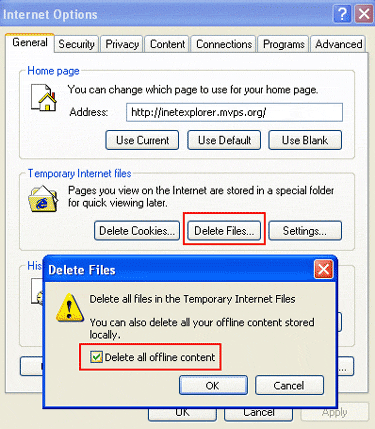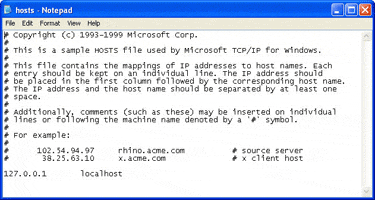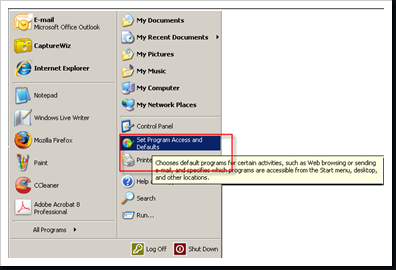Web Pages Viewing Issues
1."Page cannot be displayed" errors 2.Red x instead of pictures 3.View, Source doesn't work
To address the issues above, you may need to try one, some, or all of the following three procedures.
Empty the cache
The first thing to do when Internet Explorer is misbehaving is empty your Internet Explorer cache. Often the cache is not corrupt or damaged – it is simply too large.
1.Click Tools, then Internet Options, and then click the Delete Files button.
2.A Delete Files window will appear. Select the option to Delete all offline content, and then click OK.
3.Click Settings and reduce the size of your cache to, say, 50 to 100 MB (more if you routinely download very large files).
This will invariably fix the dreaded red x, View, Source, and sometimes "Page cannot be displayed" errors
Emptying the cache will not be sufficient to fix things if a hidden file in the cache folders, called index.dat, is corrupt.
Delete all Internet Temporary files :-
C:\Documents and Settings\username\Local Settings\Temporary Internet Files\...
Edit the HOST file
{Note: The following procedure is for advanced users.}
The HOSTS file is a hidden file used by some Internet related programs to control Web browsing by directly linking particular Web sites to pre-set IP addresses. The only problem is, if a Web page's IP address changes, the HOSTS file will not update itself to suit, causing "Page cannot be displayed" errors.
The HOSTS file can be viewed and edited using Notepad, but first we must temporarily show hidden files.
For Windows XP
1.Click Start, and then click Control Panel.
2.Click Appearance and Themes, and then click Folder Options.
For older systems
1.Double-click My Computer, click View, and then click Folder Options.
2.On the View tab, under Hidden files and folders, click Show hidden files and folders, and then clear the Hide protected operating system files check box.
Important: Files are hidden by Windows for a very good reason. It is not wise to experiment with these files. Unfortunately, to successfully complete the following steps we must turn this protection off temporarily. Please turn the protection back on when you have finished.
Find and edit your HOSTS file
The correct directory for a HOSTS file depends on what version of Windows you are running:
Windows XP = C:\Windows\System32\Drivers\Etc
Windows 2K = C:\Winnt\System32\Drivers\Etc
Win 98\ME = C:\Windows
Once you have found your HOSTS file, right-click on the HOSTS file, and then select Open. You will be asked to choose a program to use. Select Notepad, but make sure you that you do NOT turn on any option to always use the same program.
Examine the content of your HOSTS file, and compare it to the screenshot below. We do not need to worry about any line that begins with an # because is ignored by Windows. Also, the line "127.0.0.1 localhost" can be safely ignored, because it is a standard entry.
Anything else that appears in your HOSTS file without an # at the beginning, apart from the "127.0.0.1 localhost" line, should be viewed with suspicion when we are trying to diagnose the cause of "Page cannot be displayed" errors. The quickest way to test for HOSTS file involvement is to right click the HOSTS file, then select Rename. Add the letter X to the beginning or end of the file name and then ok your changes. By changing the name of the HOSTS file, we stop Internet Explorer from using it, and therefore resolve any issues caused by the file.
Repair Layered Service Provider problems
Sometimes Internet Explorer is unable to access the Internet if software known as Layered Service Provider (LSP) has been removed incorrectly from a computer. You might not know you have this software; it is sometimes installed by unrelated software such as file-sharing programs, without your knowledge. In such cases, you will need to run LSPfix or Winsockxpfix. As its name suggests, Winsockxpfix should only be used on machines running Windows XP. LSPfix can be used on all other consumer versions of Windows, but make sure that Winsock 2 has been installed on Windows 95 machines.
If you are using Windows XP Service Pack 2 (SP2) there is a command that can be used instead of Winsockxpfix. It works by resetting the winsock catalogue. Click Start, then Run and type CMD in the dialogue box that appears, and then click OK. Type netsh winsock reset into the DOS window that appears.
Issues related to default browser settings
4.Error messages when attempting to send a page or link by e-mail
First, reset your default e-mail client from within Internet Explorer. To do this go to Tools, then Internet Options, then Programs, then select your e-mail program of choice.
Sometimes your e-mail program will not appear in the drop down list shown above. When this happens, we need to re-register the program in question.
To re-register your e-mail program:
1.Click Start, then click Run, and then type the appropriate command based on the following e-mail programs:
Outlook Express:
"C:\Program Files\Outlook Express\Msimn.Exe" /reg
Outlook:
"c:\program files\microsoft office\office\outlook.exe" /checkclient
Make sure the path to msimn.exe or outlook.exe is correct for your machine. Type the command line exactly as it appears, including quote marks and spaces
5.Hyperlinks not working
Hyperlinks will not work if a computer system does not know which Web browser is set as the default, which happens if the settings that control this choice are damaged or incorrect. The easiest way to fix the problem is to allow your preferred Web browser to rewrite the appropriate settings by resetting your default browser.
How do I change my default Web browser?
This feature can be accessed in one of two ways:
1.Via the right pane of the Start menu (directly under the Control Panel icon);
2.In Control Panel, via Add/Remove Programs
Once you have opened SPAD (”Set Program Access and Defaults”)and selected the Custom option, click on the arrow button to the right of screen to reveal all available Web browser options.
Changing your default Web browser is simply a matter of selecting the one that you want to use, then clicking on the OK button.
6."Open in new Window" doesn't work
Sometimes resetting our default browser is not enough to get hyperlinks to work again, especially if they trigger a new window. Open in new window is dependent upon several system files, therefore you should ensure they are correctly registered.
Click on Start, then Run, then run the following commands. After you run each command, a small window should appear stating that the command was successful.
regsvr32 Shdocvw.dll (if that doesn't work, try shdoc401.dll)
regsvr32 Oleaut32.dll
regsvr32 Actxprxy.dll
regsvr32 Mshtml.dll
regsvr32 Urlmon.dll
Some programs that control pop-up windows and advertisements can stop hyperlinks from working. Also, some third-party add-ins are known to cause a problem and must be uninstalled when misbehaving in this way. Disable all third-party Internet related programs (not your firewall) and test.
7.Internet Explorer freezes, shuts down without warning, or the computer reboots.
This problem is often caused by out-of-date video drivers. Go to the Web site run by the manufacturer of your video card and download, then install, the latest (non-beta) drivers for your video card.
Alternatively, you can try the following:
1.Click Start, and then click Control Panel.
2.Click Display (in classic view of Windows XP), click the Settings tab, and then click Advanced.
3.Click the Performance or Troubleshooting tab (depending on your operating system), and then reduce hardware acceleration a notch at a time until your system stabilizes.
8.Internet Explorer opens off screen, or tiny, or minimized, or the window will not move
If your taskbar is set to Autohide, turn the setting off and then maximize the problem window. While the window is maximized, increase the height of your taskbar from one row to two. The maximized window will automatically resize itself to fit into the smaller area available with a taller taskbar. Then, return the taskbar to its normal single row and allow the maximized window to resize once more. This will make Windows re-calculate window size and boundaries, overwriting registry keys that may be damaged.
If the affected window is partially off screen, so that the Minimize, Maximize, Restore, and Close buttons are hidden, you can access the same options by clicking on the Internet Explorer icon on the far left edge of the Internet Explorer title bar, or by right-clicking on the Internet Explorer button on the taskbar.
If resizing your Taskbar does not work, run Regedit and remove the following registry key values which are most likely corrupt. Do not delete the entire key, just the last word which will appear in the right hand pane.
HKCU\Software\Microsoft\Internet Explorer\Main\window_placement
HKCU\Software\Microsoft\Internet Explorer\Desktop\OldWorkAreas\OldWorkAreaRects
Then reboot.
9.The computer keeps disconnecting from the Internet
This one can raise suspicions of malware. But, before you reformat your computer, do the following.
1.In Internet Explorer, on the Tools menu, click Internet Options, and then click the Connections tab.
2.Under Dial-up or Virtual Private Network settings, click the Settings button.
3.Under Dial-up settings, click the Advanced button and make sure that Disconnect when connection may no longer be required check box is cleared, and that the Disconnect if idle check box is cleared as well.
1.In Outlook Express, on the Tools menu, click Options, and then click the Connection tab.
2.Turn off the option to Hang up after sending and receiving, and then close the Options window
3.On the Tools menu, click Accounts, and then click the Mail tab.
4.Make sure that each connection is set to use Any Available. If not, highlight the account then click on Properties.
5.Click the Connection tab and ensure that the option "Always connect to this account using" is turned off
10."A runtime error has occurred. Do you wish to debug?"
This is another symptom that tends to raise suspicions of malware.
1.In Internet Explorer, on the Tools menu, click Internet Options, and then click the Advanced tab.
2.Make sure that Disable Script Debugging (Internet Explorer) and Disable Script Debugging (Other) are both enabled.
3.Make sure that Disable a Notification about ever script error is disabled.
Category: Internet Explorer, Tips, Tutorial, Windows













0 comments